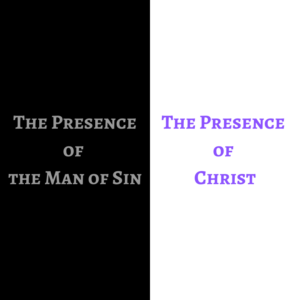
Paul wrote about two “comings” in his “great apostasy” passage (2 Thess 2:1–12). One was “the coming (Gk. parousia) of our Lord Jesus Christ ” (2 Thess 2:1, 8). The other was “the coming (Gk. parousia) of the lawless one” (2 Thess 2:9).
The popular prophetic models create confusion regarding these comings. They see them as point-in-time actions that begin and end in a short time, like the mailman “coming” to our house today.
The inmillennial prophetic model1 gives another view of these comings. Paul used a Greek word (parousia) that means presence, as I have shown (here).2 I could use it to describe our grandson’s visits each summer: Betty and I enjoy Peter’s presence for a period.
Peter and the mailman both “come” to our house. However, the mailman’s visit is a point-in-time action, and I usually have no interest in his abiding presence. But our grandson’s coming is a parousia—he comes to stay for the period his parents have set. And we always look forward to his presence.
Paul encouraged the Thessalonians regarding the presence (Gk. parousia) of the Son of Man; he warned them about the presence (Gk. parousia) of the Man of Sin. Both existed when Paul wrote this letter. Important prophetic events would soon end one presence and ensure the other would continue in the messianic age.
The Presence of the Man of Sin
The presence (Gk. parousia) of the Man of Sin—apostate Israel3—defiled the temple as Paul wrote his letter to the Thessalonians. He had ruined God’s purpose for that building.
The Lord’s glorious presence had filled three different houses of God. When Moses finished building the first house, “The glory of the LORD filled the tabernacle. And Moses was not able to enter the tabernacle of meeting, because the cloud rested above it, and the glory of the LORD filled the tabernacle” (Exod 40:34–35).
When Solomon completed the second house (the first temple), “The house of the LORD, was filled with a cloud, so that the priests could not continue ministering because of the cloud; for the glory of the LORD filled the house of God” (2 Chron 5:13–14; 7:2).
God meant for His presence to dwell in these two houses during the Mosaic age: each contained “The bread of the Presence” (e.g., Exod 25:30; 2 Chr 4:19; Matt 12:4 ESV).
But God had removed his presence from both these houses because of Israel’s sins. David said, “He forsook the tabernacle of Shiloh, the tent He had placed among men, and delivered His strength into captivity, and His glory into the enemy’s hand” (Ps 78:60–61). And Ezekiel saw the Lord’s presence depart from the temple:
The glory of the LORD departed from the threshold of the temple and stood over the cherubim. And the cherubim lifted their wings and mounted up from the earth in my sight. (Ezek 10:18–19)
In both instances, God removed his presence to judge sinful Israel.
When Paul wrote his Thessalonian letters, the apostate Jews had made the temple “a den of thieves” (Matt 21:13). It was their house (Matt 23:38; Luke 13:35), and they were of their father the devil (John 8:44). An evil presence—the Man of Sin—dwelled in the temple, not the presence of God.
The Son of Man would soon destroy that temple (Matt 24:1–2, 34).
The Presence of Christ
The Thessalonians knew God had erected a third house—the church. God had laid the Chief Cornerstone—the Lord Jesus Christ (1 Pet 2:6). Christians, “as living stones, [were] being built up a spiritual house, a holy priesthood, to offer up spiritual sacrifices acceptable to God through Jesus Christ” (1 Pet 2:4–5). The glory of the Lord had appeared in this house just as it had in the first two:
When the Day of Pentecost had fully come, they were all with one accord in one place. And suddenly there came a sound from heaven, as of a rushing mighty wind, and it filled the whole house where they were sitting. Then there appeared to them divided tongues, as of fire, and one sat upon each of them. (Acts 2:1–4)
Paul taught that the presence of Christ would dwell in his church during the messianic age. It was “a holy temple in the Lord” (Eph 2:21). Christ’s glory-presence in his spiritual temple (the church) began at Pentecost; it will never leave.
The Thessalonians knew this presence (Gk. parousia) of Christ in his new temple would require him to destroy the presence (Gk. parousia) of the Man of Sin in the old temple. They knew because Paul said, “Then shall be revealed the Lawless One, whom the Lord shall consume with the spirit of his mouth, and shall destroy with the manifestation of his presence” (2 Thess 2:8 YLT).
Conclusion
The Scriptures place two pivotal events in the parousia (presence) of Christ with his church: the temple’s fall (Matt 24:1–3, 27, 37) and the bodily resurrection (1 Cor 15:23). These events serve as “bookends” for the messianic age. At the first one, Christ judged the temple and destroyed the Man of Sin (apostate Israel). At the second, He will judge all men and destroy his last enemy—death (1 Cor 15:25–26).
Inmillennialism accepts the verb tenses Paul used. The Man of Sin was sitting in the temple (2 Thess 2:4). The mystery of lawlessness was already at work (2 Thess 2:7). This perspective makes Paul’s encouragement and warning relevant to the Thessalonians.
The popular prophetic models create confusion by making the coming of the Man of Sin and the coming of the Son of Man point-in-time events in our future.
Footnotes
- I documented this perspective in Michael A. Rogers, Inmillennialism: Redefining the Last Days (Tullahoma, TN: McGahan Publishing House, 2020). This book is available here in hardcopy and here as a PDF. A free summary PDF document of inmillennialism is here.
- For a more detailed discussion, see Rogers, Inmillennialism, 73-90.
- I identified the Man of Sin as apostate Israel here.
